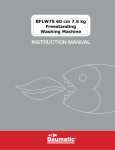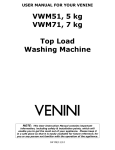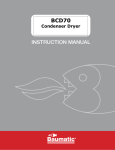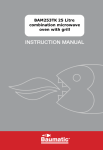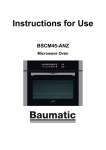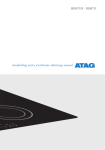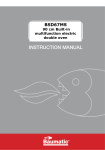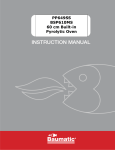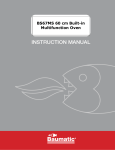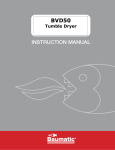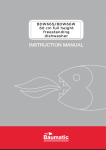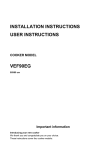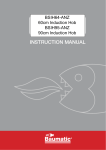Download Baumatic BWM5001 User manual
Transcript
BWM5001, 5 kg BWM7001, 7 kg Top Loading Washing Machine 2 USER MANUAL FOR YOUR BAUMATIC BWM5001, 5 kg BWM7001, 7 kg Top loading washing machine NOTE: This User Instruction Manual contains important information, including safety & installation points, which will enable you to get the most out of your appliance. Please keep it in a safe place so that it is easily available for future reference; for you or any person not familiar with the operation of the appliance. JW 18/03/13 3 Contents Environmental note Important safety information 5 6–7 Specifications Dimensions Control panel 8 – 12 9 10 - 11 Detergent drawer Bleaching agents Softener 12 12 12 Preparing the wash cycle Preparing your garments for washing A selection of wash care symbols 13 - 14 13 14 Selecting a wash program Detergent Washing load size Beginning a wash program Choosing a wash program Setting the program features Manually adjusting the wash program - Wash time - Rinse quantity - Spin speed - Temperature Selecting a water level Delay start Safety lock Imbalance control Drain hold (“Water recycling”) Changing a wash cycle 15 – 21 15 15 15 16 16 Maintenance and cleaning In daily use Control panel and washing machine cabinet Detergent drawer The washing machine drum Cleaning the filter Removing stains Stain removal rules Stain removal guide Poor wash results 22 - 27 22 22 22 23 23 - 24 24 24 25 - 26 27 Installation Locating your washing machine Adjusting the height of the appliance Installing the spacers Installing the bottom cover Connecting to the mains water supply Connecting to the water outlet Power supply Before first use maintenance wash 28 – 34 28 29 30 30 31 32 - 33 33 - 34 34 Error code failure system General troubleshooting Contact details 34 - 35 36 - 37 39 17 17 18 18 19 20 20 21 21 21 4 Environmental note 5 Important safety information Your safety is of the utmost importance to Baumatic. Please make sure that you read this instruction booklet before attempting to install or use the appliance. If you are unsure of any of the information contained in this booklet, please contact the Customer Care Department. General Safety o Repairs to your appliance must only be carried out by a Baumatic engineer or one of its authorised service agents. Any attempt by an inexperienced person to repair the appliance, could result in injury or damage to your washing machine. o If you notice that the mains cable is damaged. The appliance must not be used. The same applies if you notice that the worktop, control panel or base area is damaged. As this could allow access to the internal components of the machine. o The appliance should be turned off and isolated from the mains supply, before either cleaning or maintenance work is attempted. o The mains cable must not be used to pull the plug out of the electrical socket. o The machine should not be sprayed with water. o The machine should be allowed to cool before carrying out an emergency drain or cleaning the drain filter. o It is possible for small animals to chew either the mains cable or water hoses, which could cause an electric shock hazard. Installation o The installation instructions contained within this user manual should be followed. o It is obligatory for the completed installation to comply with all relevant building regulations and local water authority requirements. o The machine should not be installed near open flames or in wet areas. 6 During Use o It is recommended that the appliance is unplugged and the water supply is turned off after the machine is used. o This appliance is only designed to wash normal domestic wash loads. If you use your washing machine in any other way or it is incorrectly used, then Baumatic accepts no liability for any damage that might be caused and any guarantee will be void. o No attempt should be made to alter or modify the specifications of this appliance. o The detergents that you place in this appliance should be suitable for automatic washing machines. With regards to dosage levels, the detergent manufacturer’s recommendations should be followed. o You should not wash garments that have been in contact with flammable materials. o You should not wash raincoats, bike covers, feather items, stretch cotton products or other waterproof clothing in the machine. o Your washing machine should not be used for dry cleaning. o If you use either dyes or bleaching agents inside this machine, then you should consult with the manufacturer of these products to make sure they are suitable for use in your washing machine. Baumatic cannot be held responsible for any damage that may result. o The lid should not be opened when the machine is spinning. The machine will stop spinning when the lid is opened but the tub will not stop turning immediately. DO NOT place any clothes, objects or parts of your body in the tub while it is spinning. Child Safety o Your washing machine should only be used by adults. You should not allow children in the area of the machine unsupervised. You should not let them touch the controls or play with the appliance. o It could be possible for a child or pet to gain access to the washing machine through the porthole door. Therefore please check the drum before using the appliance. o Any packaging that is removed from the machine should be kept away from children. o All detergents should be kept out of a child’s reach and in a safe place. 7 Specifications 1) 2) 3) 4) 5) 6) 7) Lid Filter Interior drum Washing blades Top frame Control panel Machine body 8) Spirit level 9) Adjustable feet 10) Inlet valve 11) Power cord 12) Back cover 13) Drain pipe 14) Base o 8 programs o 5 kg wash load (BWM5001) o 7 kg wash load (BWM7001) o o o o o o o o o o o o o o o o o o o 660 rpm maximum spin speed (BWM5001) 720 rpm maximum spin speed (BWM7001) LED display Delay start Wash temperature control Imbalance control system Adjustable feet Wash phase indicator Digital countdown indicator Electronic control operation Failure detection system Stainless steel drum Overflow detection Stainless steel tub Safety lock Half load Water supply indicator Extra large porthole Full cover door without window 8 BWM7001 Appliance dimensions Height: Width : Depth: 959 mm 560 mm 565 mm BWM5001 Appliance dimensions Height: Width: Depth: 930 mm 540 mm 545 mm Energy efficiency class (Wash): 1.5 Stars For future reference please record the following information which can be found on the rating plate and the date of purchase which can be found on your sales invoice. Model Number ………………………………. Serial Number ………………………………. Date of Purchase ………………………………. 9 Control panel 1) Power ON / OFF button: Use this button to turn the washing machine on and off. If a program is not set within 5 minutes of turning the machine on, it will switch off automatically. 2) Start / pause button: Press this button to begin a wash program, or to pause / resume a program that is currently in progress. 3) Preset button: Use this button to program a delayed start to the wash cycle. 4) Program button: Press this button repeatedly to set the desired wash program. You can choose from the following options. DENIM FUZZY HEAVY DELICATE QUICK ECONOMY NORMAL AIR-DRY 5) Spin button: Use this button to adjust the spin time. 6) Rinse button: Use this button to adjust the rinse time. 7) Child lock buttons: Use these buttons (Wash & Rinse) simultaneously to activate and deactivate the safety lock. 8) Wash button: Use this button to adjust the wash time. 9) Water level button: Use this button to select the appropriate water level according to the volume of laundry. 10 10) Process button: Press this button to set the features of the wash program. Each press of the button will scroll through the following choices. 11) Water temperature button: Press this button repeatedly to choose the required washing temperature. You can select COLD, WARM or HOT. Detergent drawer o Open the washing machine lid and pull out the detergent drawer to add detergent powder to the wash program. Then push the drawer back in before introducing laundry into the machine and setting the wash program. Only powder detergents should be placed in the drawer. o If you wish to place detergent powder directly into the drum, you should dilute it first in warm water. You can then place the diluted detergent powder into the drum halfway through the main wash fill. When you lift the lid to introduce the detergent, you should ensure the machine has paused before doing so. IMPORTANT: Do not place undiluted detergent powder directly onto clothes as this can cause discoloration. IMPORTANT: You should always use a low sudsing detergent in your appliance. o Liquid detergent can also be used if it is diluted first with a lot of water and then placed into the drum. You should follow the same procedure for detergent powder but choose a slightly higher water level. 11 Bleaching agents o A bleaching agent can be used if it first diluted with plenty of water before pouring it into the drum. o You should always follow the manufacturer’s directions when using a bleaching agent to avoid damage to clothing. o You should always wash the laundry as soon as possible after the bleaching agent has been added. If the bleaching agent is allowed to sit on clothes for a long period it can cause damage. Softener o An automatic softener input device is not available with this machine. If you would like to use softener, you should pause the wash program before the last bleaching operation and introduce softener manually. o You should always follow the manufacturer’s directions when using softener to avoid damage to clothing. The amount of detergent that you need to use in your appliance will depend on: o The degree of soiling. Lightly soiled garments in general require less detergent. o The size of the wash load. A smaller wash load will require a reduction in the amount of detergent. o The hardness of your tap water. The harder your water is, then the more detergent you will need to use. The detergent manufacturers normally give guidance as to how much extra detergent should be used, depending on the hardness of the water. 12 Preparing the wash cycle Preparing your garments for washing o Your washing should be sorted out, according to the fabric type and the wash care symbol that is printed on the garment’s wash care label (see separate section on wash care symbols). o Your washing should also be sorted out according to the degree of soiling. o Check all pockets on a garment to make sure that they are empty. o Remove any detachable metal items (badges, paperclips, safety pins etc). o Zips should be closed, duvet covers and pillow cases should be buttoned up and any loose straps should be tied up. This will help to prevent other garments from getting damaged during the wash. o Woollens and knitted coloured fabrics should be turned inside out before being washed in the appliance. o Small delicate items (tights, baby socks) should be placed in either a washing net or a zipped pillow case. o Curtains should be handled with particular care. All plastic hooks or metal strips must be removed before being washed in the appliance. o Coloured items and whites should be washed in separate wash cycles. o New garments often contain an excess of dye, therefore it is advisable to wash them separately for their first wash. o Garments should be unfolded and shook out before being placed inside the machine. 13 A selection of wash care symbols Washing Boiling temp 95°C Normal temp 60°C Normal temp 40°C Do not wash! Bleachable in cold water Do not bleach! Wool seal Delicate temp 30°C Delicate temp 40°C Hand wash only All solvents All but TRI Benzine only Do not clean! Normal Low High Hang to dry Drip dry Dry flat 110°C 150°C 200°C Dry cleaning Spin dryer Do not dry! Ironing Do not iron! o The wash care symbols should be used to help you to select the most suitable wash program. They will also help you to sort your laundry into different loads, depending on the fabric type and the highest temperature which the garment can be washed at. 14 Selecting a wash program Detergent o If you are placing detergent directly into the drum, you should dilute it first (See ‘Detergent Drawer’ section). o Alternatively, put detergent powder into the detergent drawer. Please see the table below for recommended amounts according to the water level and weight of laundry. o For a normally soiled full load, dissolve dry powder detergent in warm water before adding. o Use low sudsing detergent. Washing load size o The water level and amount of detergent required largely depends on the size of the wash load. By calculating the total weight of your items you can choose the most suitable wash program options. o For a general guide to the weight of various laundry items, please see the table below. Laundry item 1 x Sheet 1 x Pillowcase 1 x Quilt cover 1 x Tablecloth 1 x Teacloth 1 x Bathrobe 1 x Towel 1 x Pair of Denim 1 x Shirt 1 x Nightdress Underwear Approximate weight (g) 400-500 150-200 700 400-500 100 900-1200 500 400-500 150-200 200 100 IMPORTANT: The weights stated in the above table are approximate. The weight of individual items can vary depending on fabric, size and quality. Beginning the wash program o Once you have set the correct wash program, you should check that the lid is securely closed and then press the start / pause button (2) to begin the program. o If you wish to pause the program at any time then press the start / pause button (2), and then press it again to resume. 15 Choosing a wash program o Place the laundry into the washing machine and close the lid. o Use the program button (4) to select the most appropriate wash program for your laundry. Please see the table below for a general guide: Wash program DENIM FUZZY HEAVY DELICATE QUICK ECONOMY NORMAL AIR DRY Recommended laundry To wash heavy duty clothes like Denim and work uniforms. This program automatically adjusts the water level according to the weight of the laundry. To wash coats, Denim and other big clothes. For washing wool or underwear or other delicate items. To wash only slightly dirty clothes. Reduces the wash times and amount of water to reduce energy consumption Regular washing. Allows airflow to the drum during the spin cycle, helping to speed the drying of the laundry. IMPORTANT: A NORMAL cold wash setting should be used for lightly soiled loads, and for normally soiled full loads a NORMAL warm wash setting should be used. Setting the program features o The machine will automatically set a default wash cycle that consists of a wash, rinse and then drain. If you wish to program alternative wash features, you can use the process button (10) to choose from the following options: NOTE: If you select the “Delicate” wash program, the option of “Soak, Wash, Rinse, Spin” is not available. NOTE: If “Quick” or “Air-Dry” programs have been selected, then the process button will not operate as these cycles can not be modified. 16 Manually adjusting the washing cycle times o After you have selected your desired wash program, the cycle times will be displayed. If desired, you can then adjust the Wash, Rinse, and Spin times. Wash time adjustment o Adjust the amount of time the appliance washes the laundry by pressing the Wash button (8). o The wash times are indicated below, you can scroll through the times by repeatedly pressing the Wash button. IMPORTANT: You cannot adjust the wash times for “Quick” or “Air dry” wash programs. Rinse time adjustment o Adjust the amount of times the appliance rinses the laundry by pressing the Rinse button (6). o The rinse times are indicated below, you can scroll through the times by repeatedly pressing the Wash button. IMPORTANT: You cannot adjust the rinse times for “Quick” or “Air dry” wash programs. NOTE: The Default rinse for the “Normal” was program is 1 time. The default rinse for “Denim, Fuzzy, Delicate and Economy” is 2 times; the default rinse for “Heavy” is 3 times. 17 Spin time adjustment o Adjust the amount of time the appliance spins the laundry by pressing the Spin button (5). o The available spin times are indicated below, you can scroll through the times by repeatedly pressing the Spin button. IMPORTANT: You cannot adjust the rinse times for “Quick” or “Delicate” wash programs. NOTE: The spin time for “Air dry” can only be cycled through the times below: Selecting a wash temperature o You can use the wash temperature button (11) to adjust the wash temperature for your chosen program. The table below shows an approximate temperature for each option: Temperature option Approximate temperature Warm 35°C Hot 45°C Cold 5°C o IMPORTANT: If the washing machine is not connected to a hot water supply, you should not select the hot or warm temperature options. 18 Selecting a water level o You can also select a water level for your wash program, according to the amount of laundry that you are washing, using the water level button (9). o The default program is “Fuzzy”. The “Fuzzy” program automatically detects the weight of the laundry and sets the water level accordingly. o However, should you want to select your own water level then please see the table below for a guide to the appropriate water level for different load sizes and the required amount of detergent. BWM5001 Water level 9-10 Laundry weight (kg) 4-5 7-8 3-4 5-6 2-3 3-4 1-2 1-2 Less than 1 Water volume (litres) 50 46 43 39 36 32 29 25 22 18 Normal wash powder 40g/30L 67 61 57 52 48 43 39 33 29 24 Concentrated wash powder 25g/30L 42 38 36 33 30 27 24 21 18 15 Water volume (litres) 62 57 52 47 42 37 32 28 24 20 Normal wash powder 40g/30L 83 76 69 63 56 49 43 28 32 27 Concentrated wash powder 25g/30L 52 48 43 39 35 31 27 23 20 17 BWM7001 Water level 9-10 Laundry weight (kg) 5.5-7 7-8 4-5.5 5-6 2.5-4 3-4 1-2.5 1-2 Less than 1 IMPORTANT: A high water level should not be selected for a washing load below 1 kg as water can splash during the cycle. NOTE: You cannot adjust the water level under the “Quick” or “Air dry” wash programs. 19 Delay start You are able to delay the start of a wash cycle so the laundry is finished at a time that is most convenient to you. o You should introduce the detergent into the detergent drawer or drum and then add the laundry as normal. You can then select your required wash program following the instructions outlined in the previous section. o Instead of pressing the start / pause button (2) to begin the program straight away, you should press the preset button (3) to set a delayed time. o Each press of the preset button (3) will increase the delay time by 1 hour. The number of hours displayed indicates when the wash cycle will come to an end. o The washing machine will begin the program automatically, at an appropriate time to ensure that the wash program is complete by the time you have set. For example, if you program a delay time of 3 hours, this means that the wash program will be finished in 3 hours. o You can set a delay time from 2 to 24 hours. NOTE: If you want to cancel a delay start you must turn off (restart) the machine. You will need to then reset your program / options again. Safety lock In order to prevent any inadvertent operation of the control panel, you can set a safety lock to deactivate all of the buttons. o After the wash program has started, press the Rinse button (6) and the wash button (8) simultaneously for about 2 seconds. The machine will then beep to indicate that it has entered the safety lock state. o All the buttons will be deactivated and the display will show “Child Lock” displayed in the LED display. o To release the safety lock, press the Rinse button (6) and the wash button (8) simultaneously for about 2 seconds again. The machine will beep again and the “Child lock” will be deactivated and will go out on the LED screen. 20 Imbalance control o If the laundry load is unbalanced when the washing machine begins to spin, the cycle will stop while more water is added to redistribute the load. This process may be repeated until the load is sufficiently balanced for the spin to continue. o If there is excessive vibration during the spin part of the program, you should open the lid and wait until the drum stops moving. You should then redistribute the load evenly in the machine. o When the lid is closed, the spin part of the cycle will restart automatically in a few seconds. Drain Hold (“Water Recycling”) o The “water recycling” function means that the machine will not execute the last drain of the wash cycle. This means that the laundry will sit in the water until you are ready to remove it for drying, preventing it from developing creases. o After you have selected a wash cycle, press the ‘Process’ button (10) to turn the water recycling mode on. Ensure that “Water recycling” lights on the LED display. To turn the water recycling mode off you should press the process button until the water recycling light goes out on the LED display. o At the end of the wash cycle the water will not drain and “water recycling” will flash in the display. The machine will also beep every 5 minutes. When you are ready to complete the wash cycle and drain the water you should press the “process” button and the machine will then execute the last drain of the water. o NOTE: There is the option here to manually drain the water using the drainage pipe if you desire. This way you can ‘recycle’ the water. Please ensure you have an adequate container ready for the water. (BWM5001 = 51L+, BWM7001 = 61L+) Changing a wash cycle o If you want to change your wash program after it has started you can do so by pausing the current washing cycle by pressing the start/pause button (2). o You can then select your desired wash program. o Press start/pause button (2) to resume washing with the new wash cycle. 21 Maintenance and cleaning In daily use o Once a wash cycle has completed, you should pull out the detergent drawer slightly, so it can dry out. o Leave the lid open for a short while after a wash cycle has completed. This should help to prevent stagnant smells and to protect the seal. o Close the water tap. o We suggest that you disconnect the appliance from your mains supply when it is not in use. IMPORTANT: Never pour water onto the washing machine as there is a risk of electrical shock. Control panel and washing machine cabinet. IMPORTANT: Do not use any abrasive cleaner or household polish on either the control panel or operating parts. o Wipe over the control panel and the external surface of the machine using a brand new damp cloth with warm water. o If you ever spill any liquid detergent or conditioner from the detergent drawer onto the washing machine cabinet, then these should be cleaned up immediately as they could be corrosive. Detergent drawer Occasionally the detergent drawer should be cleaned, to remove any detergent residue that has built up. o Remove the drawer and wash in warm, soapy water. o Detergent can also accumulate inside the detergent drawer recess, so you should also clean this out using a brush. o Once you have finished cleaning the detergent drawer and recess, you should slide the drawer back into its original position. 22 The washing machine drum The drum of your washing machine is constructed from stainless steel. However if there are objects that can rust placed inside the drum, then it is possible for the drum to become stained. IMPORTANT: Do not use a descaling agent, iron/steel wool or scouring agents to clean the drum of your appliance. o Remove any rust stains on the drum with an appropriate stainless steel cleaning agent. Cleaning the filter IMPORTANT: Switch off your washing machine and disconnect the plug from your mains supply. If your appliance comes fitted with a filter, you should clean it out approximately every two months. If the filter is not cleaned regularly, then your appliance may find it difficult to pump out water efficiently. o You should regularly check to see if any deposits have formed, or there are any foreign bodies in the filter. o Locate the filter flap that is on the side of the washing machine drum. o Detach the filter from the drum wall. o Reverse and pull out the filter bag and then wash in warm soapy water before drying thoroughly. 23 o Reattach the filter bag and then clip the filter back into position on the drum wall. Removing stains Garments that are covered in stains, grease or are heavily soiled may need to be pre-washed or soaked before being placed inside of the washing machine. o Soaking helps to remove protein-type stains, like blood, milk or grass. o Pre-washing by hand helps to loosen soil before the main wash. Stain removal rules o Use warm water for soaking or pre-washing stained laundry. Hot water can set stains. o Most stains are easier to remove when they are fresh. o Before treating any stain try to establish; what kind of stain it is, how old the stain is, what the fabric type is and whether the fabric is colourfast (check the care label to find this out). o Washing and drying can fix some stains. o When bleach is recommended, use a mild fabric bleach that is safe for the fabric. o If you need to use a stain remover, put the stained area face down on a paper towel or white cloth. Apply the stain remover to the back of the stain. This forces the stain off the fabric, instead of through it. 24 Stain removal guide Stain Alcoholic beverages Shoe polish Tea and coffee Chocolate and cocoa Tomato paste Removal Method The stain should be first washed with cold water, then wiped with glycerine and water and rinsed with water mixed with vinegar. The stain should be softly scratched without ruining the material, then rubbed with detergent and rinsed. In case it is not eliminated, rub with 1 unit of pure alcohol (96 proof) mixed in 2 units of water and then washed with lukewarm water. Stretch the stained area of material on the top of a container and pour water as hot as the material can endure on it. If the type of material is suitable, wash it with caustic soda. Leave your clothes in cold water and rub with soap or detergent, wash it in the highest temperature that the material type can endure. If there is still a stain of oil left, wipe with oxygenated water (in proportion of 3%). Scrape the dried pieces without ruining the material, then leave in cold water for about 30 minutes and wash by rubbing with detergent. Meat broth/ egg Eliminate the dried stain residues and wipe with a sponge or soft cloth wetted in cold water. Rub with detergent and wash with diluted caustic soda. Grease and oil stains First wipe the residues. Rub the stain with detergent and then wash with lukewarm soapy water. Mustard First apply glycerine to the stained area. Rub with detergent and then wash. If the stain still does not disappear, wipe with alcohol (on synthetic and coloured cloth, a mixture of 1 unit alcohol, 2 units water should be used). Lay your clothes in cold water for 30 minutes. If the stain still does not disappear, lay in mixture of water and ammonia (3 table-spoons of ammonia in 4 litres of water) for 30 minutes. Lay your clothes in cold water and rub the stained area with detergent. If the stain has still not disappeared, apply caustic soda on the fabric of your clothes in proper proportion. (Do not use caustic soda on coloured clothes). Mould stains should be cleaned as soon as possible. The stain should be washed with detergent, and if it does not disappear, it should be wiped with oxygenated water (in proportion of 3%). Hold the stained area under cold water and wait until the inky water completely runs off. Then rub with water diluted with lemon juice and detergent. Wait five minutes and then wash. Stretch the stained area of your clothes on the top part of a container and pour cold water on it. Do not pour hot water on the stain. Wipe with cold water and apply glycerine. Wait for 1-2 hours and rinse after wiping with a few drops of white vinegar. Blood stain Cream, icecream and milk Mould Ink Fruit 25 Grass stain Oil paint Burnt stain Rub the stained part with detergent. If the type of fabric is suitable for use of caustic soda, wash it with caustic soda. Rub your woollen clothes with alcohol (for coloured one, a mixture of 1 unit pure alcohol and 2 units of water). The stain should be eliminated before it dries by applying thinner on it. Then it should be rubbed with detergent and washed. If your fabric is suitable for use of caustic soda, you can add caustic soda into your washing water. For woollen fabric, a cloth dampened in oxygenated water should be pressed on the stain and it should be ironed with a dry cloth on it. It should be washed after rinsing well. 26 Poor wash results My garments are looking grey and there are limescale deposits present in the drum of my washing machine. o o o o There is not enough detergent being added. The incorrect detergent is being used. Stains are not being pre-treated. The correct wash program or wash temperature was not selected. I have followed the advice given above, but my garments are still coming out with grey stains on them. o The garments are soiled with oils, ointments or grease and were washed without enough detergent. o The wash temperature selected was too low. o Fabric conditioner has come into contact with the garments. If this happens try to wash out these stains as quickly as you can and try to avoid getting conditioner on the garments in future. After the final rinse, I can still see foam. o Modern detergents can result in there still being foam in the final rinse; this does not mean that the washing is not being rinsed properly. There is white residue on my garments when I remove them from the appliance. o Modern detergents can contain insoluble contents; white residue after a wash cycle is not necessarily a sign of the garments being insufficiently rinsed by the washing machine. o You should shake out the garment or brush it off. In future possibly turn the garment inside out before it is washed. You may wish to move from a powder detergent and switch to a liquid detergent instead. 27 Installation IMPORTANT: THIS INSTALLATION MUST BE COMPLETED BY A SUITABLY QUALIFIED PERSON. BAUMATIC ONLY SANCTION THE INSTALLATION GIVEN IN THIS INSTRUCTION MANUAL. YOU SHOULD KEEP THE TRANSIT PACKAGING, IN CASE YOU NEED TO TRANSPORT THE MACHINE IN THE FUTURE. Locating your washing machine o Before commencing installation, check the location where you intend to install the appliance. You should make sure that you have everything in place that is necessary for the correct installation. o Do not place or store your washing machine in a location where the ambient temperature could fall below 0°C, otherwise the water in it could freeze up. o Never place or store laundry products on top of the appliance. o Install the washer on a flat, solid floor. If the washer is installed on an uneven or suspended floor, it could cause excessive noise and severe vibration, which may result in the malfunction of the appliance. DO NOT PLACE THE WASHING MACHINE ON A CARPET OR A SUSPENDED FLOOR. o You should also level off the washing machine using the adjustable feet on the base of the appliance. There is a spirit level on the top of the appliance to assist you in ensuring the appliance is level. o There should be a gap of 5 cm either side of the washing machine; a 5 cm gap should be left behind the appliance. 28 Adjusting the height of the appliance o Place the machine on a solid and level floor surface. o If the floor is uneven, the appliance should be adjusted otherwise the washing machine will not function properly. The uneven surface also vibrates the machine and causes it to move from its original position while in use and will create more noise. o Utilising the spirit level on the top of the appliance will help you level the appliance. o The adjustable feet of the washing machine allow you to correct the levelness of the appliance. o First unscrew the adjusting nut using a spanner. o Adjust the height of the legs by rotating the foot. o When the appliance is set to the correct height, screw the nut back tightly to lock into position. o Make sure that the washing machine does not move when you press down the top four corners of the machine. IMPORTANT: There should be no instability of the machine when the adjustable legs have been set to the correct level. 29 Installing the spacers o Remove the spacers from the accessories provided with the appliance. o Each spacer has two clasps as shown in the drawing below. Ensure that clasp A is secured to the right hand slot of hole 1. Clasp B should be secured to the left hand slot of hole 1. o Fix the second spacer to hole 2 using the same method as above. Installing the bottom cover o The bottom cover should be placed between the machine case and the foam lining. o After unpacking the machine, turn the appliance upside down gently onto a soft surface such as a towel or blanket. o Insert the bottom cover in the groove on the base from the back of the machine and fasten it in place with the self-tapping screws supplied. 30 Connecting to the mains water supply IMPORTANT: The washing machine should never be connected to the water mains using an existing inlet hose, YOU MUST utilise the inlet hose that is provided with the appliance. Your appliance should be connected to a cold and hot water supply. o Ensure that a washer is placed inside the inlet pipe joint, as shown in the image, or the inlet pipe is at risk of leaking. o Connect the inlet pipe to the water supply tap using the screw thread. Make sure it is securely connected. o Ensure that a washer is placed inside the other end of the inlet pipe joint to prevent the pipe from leaking. o Place the inlet pipe into the inlet valve at a vertical angle and fasten it securely. o Connect the cold water source to the cool inlet valve using a cold inlet pipe. Connect the hot water source to the hot inlet valve using a hot inlet pipe. Do not confuse the two inlet pipes. 31 Connecting to the water outlet o Remove the accessories which will include a drainage pipe, clamp and sealing ring. o Position the clamp over the drainage pipe. o Fix the sealing ring onto the water outlet port. o Attach the drainage pipe over the sealing ring onto the water outlet port. o Reposition the clamp over the drainage pipe and sealing ring. o Secure the drain hose to the water outlet, so that it cannot move whilst the washing machine is in use. The correct position of the drain hose is one which will prevent any water leaking onto the floor or other surfaces. 32 o The drain hose should not be positioned any higher than 90 cm as this will cause drainage problems. o You can place the end of the drain hose in your drain pipe. Push it a short way down into your drain pipe (max 100mm). IMPORTANT: Do not insert the drain hose too deeply into the water pipe, as this may cause siphoning. The drain hose should be loosely fitted and not sealed. o Alternatively, you can place the end of the drain hose into a sink. You can secure the hose to the tap to hold it in position. o ALWAYS use an elbow to bend the drain hose at a proper bending angle. Fix it well when using the elbow. o NEVER EXTEND THE DRAINAGE HOSE FROM ITS ORIGINAL LENGTH. o You should ensure that the drain hose is not kinked or knotted before using the machine. Power supply o IMPORTANT: The electrical socket must still be accessible once the appliance is installed. o Consult the rating plate BEFORE making the electrical connections. Ensure that the voltage reaching the plug is the same as that on the rating plate. o DO NOT REMOVE THE RATING INFORMATION ON IT IS IMPORTANT. PLATE AS THE 33 o The moulded plug that is supplied with the appliance must be placed into an earthed and insulated socket. o Broken or damaged power leads must only be replaced by a suitably qualified person. A power lead of a similar type must be used in replacement. o IMPORTANT: We do not recommend that this appliance is connected to an extension lead. Before first use maintenance wash o When your washing machine has been correctly installed, we recommend that you perform a maintenance wash cycle, without any clothing being placed inside of the drum. o This will check that all aspects of the installation are correct; it will also remove any deposits that may have been left on the drum by the manufacturing process. o Select the NORMAL program (see the “Setting a wash program” section). Error code failure system If your appliance senses that it is not operating correctly, then an error code may appear on the LED display. The following error codes can possibly be remedied by the customer and the steps outlined below should be followed. BEFORE COMPLETING ANY MAINTAINEANCE ON APPLIANCE, IT SHOULD BE DISCONNECTED FROM YOUR POWER SUPPLY. Error code E1 Problem Water not draining. Reason o o E3 Excessive noise during spin. o Drainage pipe is kinked or blocked so the water cannot be drained. The drain pipe is located above 90 cm from the ground. The laundry is not distributed evenly in the drum, so the load is colliding with the drum wall creating noise. THE Solution o Open the lid after the drum has stopped spinning and check the drainage pipe. o The machine will try to correct the load twice before omitting a warning. Open the lid and redistribute the load when the drum stops moving. o 34 E4 Very little water is supplied. o E6 Abnormal water level sensor. Constant water supply or automatic drainage. o E7 o Tap is not turned on; there is a water failure or low water pressure so the water cannot reach the set level after a long time. Water level sensor failure, short circuit or circuit break. Abnormal inlet valve or water level sensor. o Turn on the tap or re-use when the water pressure is normal. o Call the Customer Care Helpline. Turn off the power supply after drainage and call the Customer Care Helpline. o If a fault code reappears after following the above advice and clearing the fault code. You should turn the washing machine off using the POWER button. Disconnect the appliance from your mains supply. Then arrange for an engineer to attend the appliance. You should contact the Baumatic Customer Care Department on 1800 444 357. IF AN ENGINEER ATTENDS DURING THE GUARANTEE PERIOD AND FINDS THAT A FAULT HAS BEEN CAUSED BY AN ITEM ON THE ERROR CODE LIST, WHICH COULD HAVE BEEN CLEARED BY THE CUSTOMER, THEN YOU MAY BE LIABLE FOR THE COST OF THE SERVICE CALL. 35 General troubleshooting Problem o When the machine starts from the RINSE function, the washing machine does not add water. o o The wash process changes from SPIN to RINSE. o o The control panel is not responding during a program. o o o There is a SPIN delay. o o The first time the machine is used, there is some water flowing out the drainage pipe. o Machine is completely unresponsive. o Possible solution The washing machine will start from the SPIN process in order to spin out the water and detergent from the clothes, then input the water (if there is water in the tub it will drain out the water first). When the clothes are not even inside the tub, the washing machine will input the water and make the clothes balanced and even. If you want to change the cycle after the washing machine has started, press the pause button and then change the program. Check that the safety lock is not activated. The washing machine will delay 15 to 60 seconds to enter the SPIN process after DRAIN or after select SPIN process only. This is remaining water only, which is from the factory checking process. o There is a loose connection in the power socket which needs tightening. o The fuse is broken. Call an electrician to check the socket or fuse. o Power cut. o Voltage is too high or low. 36 IMPORTANT: If your appliance appears not to be operating correctly, then you should disconnect it from your mains supply and then contact the Customer Care Department DO NOT ATTEMPT TO REPAIR THE APPLIANCE YOURSELF. Please note that if an service agent is asked to attend whilst the product is under guarantee and finds that the problem is not the result of an appliance fault, then you may be liable for the cost of the call out charge. The appliance must be accessible for the service agent to perform any necessary repair. If your appliance is installed in such a way that an engineer is concerned that damage will be caused to the appliance or your kitchen, then they will not complete a repair. This includes situations where appliances have been tiled in, sealed in with sealant, have wooden obstructions placed in front of the appliance - like plinths, or any installation other than the one specified by Baumatic Ltd. has been completed. Please refer to the conditions of guarantee that appear on the warranty card that you receive with the appliance. IMPORTANT: Baumatic Ltd. operates a policy of continuous improvement and reserves the right to adjust and modify its products without prior notification. 37 38 Think Appliances Pty Ltd. 416-424 Barry Rd Coolaroo VIC 3048 Sales Telephone 1300 132 824 Service Telephone 1800 444 357 Website www.thinkappliances.com Applico Ltd. P.O. 92900 Onehunga, Auckland, New Zealand 1061 Website www.baumatic.co.nz United Kingdom Baumatic Ltd., Baumatic Buildings, 6 Bennet Road, Reading, Berkshire RG2 0QX United Kingdom Sales Telephone (0118) 933 6900 Website: www.baumatic.co.uk 39 35








































